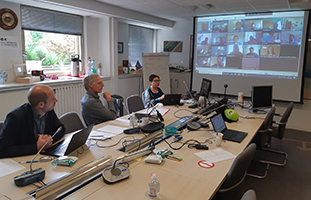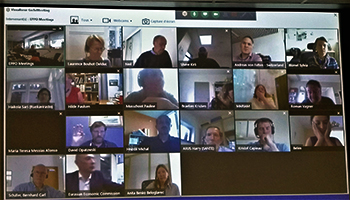
58th Meeting of the Working Party on Phytosanitary Regulations
Teleconference, 2020-06-17/19
The meeting of the Working Party on Phytosanitary Regulations met by videoconference due to the COVID-19 situation. There were 22 participants from 20 EPPO countries and observers from the European Commission, the Eurasian Economic Commission and USDA-APHIS. This EPPO Working Party directs and supervises the technical work of many EPPO Panels related to plant health. A summary of the different Panel meetings and Workshops which took place since the last meeting was presented to the Working Party (short summaries of these meetings are posted on this website). The Working Party also discussed the work programme for 2021 and made several recommendations that will be presented to the EPPO Council.


New and revised EPPO recommendations and Standards
The Working Party recommended that 5 new pests (including 2 invasive alien plants) should be added to EPPO Lists of pests recommended for regulation as quarantine pests: Gymnandrosoma aurantianum and Naupactus xanthographus to the EPPO A1 List of pests absent from the region; Amaranthus palmeri, A. tuberculatus and tomato brown rugose fruit virus to the EPPO A2 List of pests present in the region. For each pest, recommended phytosanitary measures are described in a Pest Risk Analysis.
10 new and revised Standards were considered ready to be presented for approval at Council:
- Phytosanitary Procedures (series PM3)
- Testing of potato varieties to assess resistance to Synchytrium endobioticum (new)
- Control of volunteer potato plants (new)
- Inspection of citrus fruits consignments (new)
- Phytosanitary Procedures: Inspection of consignments for Xylella fastidiosa (revision of PM 3/81)
- Phytosanitary Procedures: Inspection of places of production for Xylella fastidiosa (revision of PM 3/82)
- Sentinel woody plants: concepts and application (new)
- Guidelines on Pest Risk Analysis (series PM5)
- Decision-Support Scheme for an Express Pest Risk Analysis (corrigendum for PM 5/5 with links to additional guidance)
- Decision-Support Scheme for an Express Pest Risk Analysis (corrigendum for PM 5/5 with links to additional guidance)
- National Regulatory Control Systems (series PM9)
- National regulatory control system for Bactericera cockerelli and ‘Candidatus Liberibacter solanacearum’ (revision of PM 9/25)
- Ambrosia confertiflora (new)
- Heracleum mantegazzianum, H. sosnowskyi and H. persicum (revision of PM 9/9)
The Working Party also noted the adoption of the following Diagnostic Protocols approved since its last meeting according to the specific fast-track procedure:
- PM 7/78 Verticillium non alfalfae & dahliae
- PM 7/ 18 Monilinia fructicola
- PM 7/143 ‘Candidatus Liberibacter solanacearum’
- PM 7/142 Bactrocera latifrons
- PM 7/91 Fusarium circinatum
- PM 7/141 Philaenus spumarius, Philaenus italosignus and Neophilaenus campestris (vectors of Xylella fastidiosa)
- PM 7/140 Heterobasidion irregulare
- PM 7/XX Tospoviruses
- PM 7/62 ‘Candidatus Phytoplasma mali’, ‘Ca. P. pyri’ and ‘Ca. P. prunorum’
- PM 7/27 Puccinia horiana
Information services
The Working Party was briefed on the activity launched to revise the EPPO datasheets (and also to create new datasheets where needed) and make these at the same time more dynamic. The work was launched under a pilot project on 11 datasheets for important pests of the Mediterranean area with Euphresco and the International Center for Advanced Mediterranean Agronomic Studies (CIHEAM) during summer 2019, and continued under a grant agreement signed in March 2020 between EPPO and the European Commission for the development/revision of a list of 321 datasheets. At present, 13 datasheets have been published in EPPO GD and 72 are in progress.
Diagnostics
The Working Party was briefed on the main achievements of the five Panels and the Workshop on Diagnostics held since the last meeting. The EPPO Secretariat presented the progress made on the EPPO-Q-bank database and recalled that one aim of the database is also to provide information on where biological material is available. The Working Party supported the organization of a questionnaire to laboratories to confirm their willingness and capacity to provide their data on biological material via EPPO-Q-bank before engaging in further IT development.
The Working Party was also briefed on a Valitest Project activity aimed at improving interactions with stakeholders. The Working Party noted that the Standards PM 7/84 Basic requirements for quality management in plant pest diagnosis laboratories and PM 7/98 Specific requirements for laboratories preparing accreditation for a plant pest diagnostic activity will be further aligned in 2021.
PRA activities
The Working Party agreed that Expert Working Groups for PRA should be organized for the invasive alien plant Celastrus orbiculatus, and, by order of priority, on Chrysobothris femorata (which damages woody deciduous plants), Orgyia leucostigma (polyphagous lepidoptera) and Chionaspis pinifoliae (Diaspididae damaging conifers). These two last pests were identified by the Nordic PRA Network, which offered to prepare the first draft PRAs.
Phytosanitary measures
The Working Party suggested that a videoconference is organized in 2021 with experts on Standard PM 3/66 Guidelines for the management of plant health risks of biowaste of plant origin to discuss the scope, gaps of knowledge and needs for revision before the revision is launched. The Working Party also suggested that revision of Standard PM 4/17(2) Pathogen-tested olive trees and rootstocks is initiated. It also recommended that the EPPO Secretariat evaluates where EPPO can have added value on the technical work coordinated by the IPPC on Spodoptera frugiperda and how this fits into the work programme. Work on draft Guidelines on the design and implementation of a buffer zone which was tested on Heterobasidion irregulare and the thousand cankers disease (Geosmithia morbida) with the support of an EFSA facilitator should continue.
Biological Control Agents
The Working Party agreed with the Panel proposal to add Trichogramma cordubensis to Standard PM 6/3 List of biological control agents widely used in the EPPO region but requested more information on Anastatus bifasciatus and Heterorhabditis downesi before adding these species to the List. The Working Party asked the Panel on Biological Control Agents to work further on harmonizing the format of the dossiers submitted as well as on the level of detail.
Plant Health Links in the EPPO Region
The following issues were discussed:
- EPPO activities in the context of the international Year of Plant Health 2020
- ePhytos
- IPPC Sea container task force
- Progress in the implementation of the EU Regulation
2016/2031 ‘on protective measures against pests of plants’ and EU Regulation2017/625 ‘on official controls and other official activities’ - Euphresco
Review and improvement of EPPO processes
A new Strategic plan should be approved for
Other business
It was discussed how acknowledgement of authors of Standards could be made more visible. The EPPO Secretariat will work out how to implement this.
The next Working Party on Phytosanitary Regulations is due to convene in 2021, including a joint session with the Working Party on Plant Protection Products to help improve links between phytosanitary regulations and plant protection products policy.
